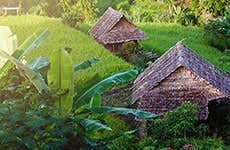
Rice Fields
Bali's rice terraces form boundless green landscapes that are characteristic of the island, and a must-see for tourists. Read about their significance in Balinese society and which ones to visit.
Rice fields in Bali make up a breathtaking scenery that features in many postcard images of the island. However, despite their beauty, rice fields do not serve an aesthetic purpose, but rather they are an essential part of Balinese agriculture and traditional life.
The mountainous structure of the land means that rice cultivation is not an easy task, something that the Balinese solved with staggered rice terraces, some of which have taken several centuries to build. A system of canals called the Subak Irrigation System carries water from the springs to the rice fields to keep them waterlogged, and after 210 days the rice is ready to be harvested.
Balinese people view rice as a gift from God and a symbol of life. Farmers pay special tribute to Dewi Sri, Goddess of Rice and Fertility, with small shrines they place in the fields. Visiting the rice fields is a nice way to get away from the hustle and bustle of tourist areas and witness the true soul of Bali.
One of the most impressive rice fields is Jatiluwih, which is included in UNESCO's World Heritage Cultural Landscapes list. Tegallalang is also popular and easier to get to, just a short drive up from Ubud. To get to the rice paddies you can hire a scooter or a car or take a taxi. Some guided tours also include transfers from your hotel.
Tips
- On your way to the rice fields, locals may ask for small donations of around 10 IDR (US$ 0), so make sure you have change on you.
- It's better to go earlier in the day to avoid the midday heat as well as the crowds.
- Bring water and snacks.



